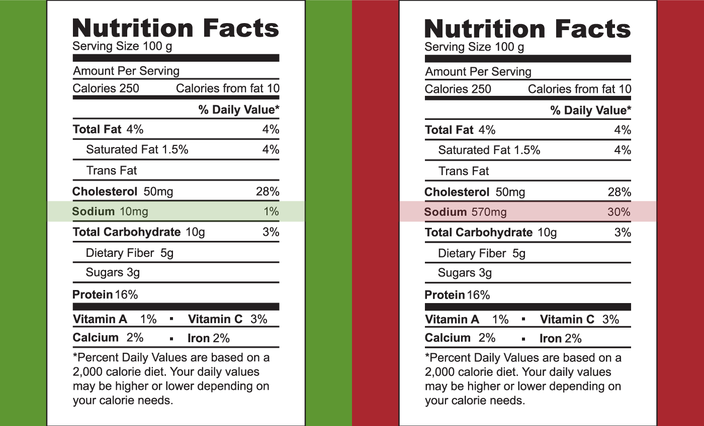If you’re a self-diagnosed sugar addict like me, I have bad news for you.
You’re probably a salt addict too. You may be wondering how this is
possible, especially if you always choose sweet over salty. But the fact
is,
9 out of 10 Americans consume too much sodium. That’s why I spoke with registered dietitian and certified diabetes
educator Janelle Eligon-Ketchum of
Nutrition Unlimited. She helped me understand how much sodium is considered too much and
showed me how to pay better attention to the foods I’m eating.
Q: What is sodium and why do I need it?
You’re probably most familiar with sodium because it’s a major component of
salt. Your body needs it to help keep your fluid levels in balance. For
example, salt ensures your body has the fluids it needs to sweat.
What happens when I get too much sodium?
Eating too much salt can raise your blood pressure and increase your risk
for
hypertension. It can also increase your risk for
heart disease
and
kidney disease. For some people, eating too much salt can cause bloating, swelling, or
headaches.
How much sodium do I need?
According to the
Office of Disease Prevention and Health Promotion, it is recommended that you consume less than 2,300 milligrams of sodium
per day. I know, that sounds like plenty! But once you start looking at
nutrition labels, you’ll learn just how quickly it adds up. In fact, the
American Heart Association claims that the average American consumes
about 3,400 mg of sodium per day
— that’s 1,100 more milligrams than we’re supposed to eat. And if you have
certain chronic conditions, you may need to limit your sodium intake even
more.
Is there an easier way to identify foods with too much sodium?
Yes, the 5-20 rule is easy to remember and can help you identify lower
sodium foods. Here’s how it works:
-
Look at the nutrition label on your food.
-
Find sodium and look at the percentage listed next to it.
-
If the food contains 5 percent of your daily value for sodium, it’s
considered a low sodium food. If it contains 20 percent, you know it’s
a high sodium food and you should try to avoid it.
What kinds of foods tend to be high in sodium?
Processed foods, like prepared foods and sauces that come in boxes or cans,
often have very high levels of sodium. For example, your favorite boxed
macaroni and cheese has 570 mg of sodium in one small serving, that’s 30
percent of your daily value! Your comforting can of chicken noodle soup has
28 percent, and a small handful of pretzels has 10 percent. But
sodium also hides in other foods
as well, such as breads, cereals, cheese, deli meats, and pizza.
Do you have any tips to help lower my sodium intake?
Cooking your meals at home, rather than eating out, is a great way to lower
your sodium intake, but you have to be careful about how you’re preparing
your foods. These tips can help:
-
Opt for powders over salts, like garlic and onion powder.
-
Season your foods with herbs and spices.
-
Don’t be fooled by sea salt, kosher salt, pink Himalayan, or any other
kind of fancy salt. It’s still salt and made up of sodium.
-
Try to avoid shortcuts, like prepared sauces, spice mixes, and rice
mixes.
-
Remove the salt shaker from the dinner table.
How can I watch my sodium intake when I’m eating out at a restaurant?
Sodium levels tend to be very high in foods at restaurants, and not just
fast food restaurants. The best thing you can do is really limit how often
you eat out. Save it for special occasions, like what you probably did when
you were growing up. Today, we eat out so often, several times a week or
more seems to be the norm. But to get back to eating healthy, you need to
try to prepare more meals at home so you can control what’s going into your
meals. This is a tough change but it can make a huge difference in your
overall health. Meal delivery services may be a good way to start out since
there are plenty of them that deliver healthy, fresh ingredients for you to
prepare. Plus, you can still control the amount of salt and seasonings that
go in them.
Where else can I get help learning how to eat healthier?
Watching what you eat, changing habits, learning new cooking methods — it
all takes time. But it’s even easier with help from a professional. If
you’re an IBX member, chances are you’re covered for
six free annual visits with a registered dietitian
who can help you come up with a healthy meal plan and stick to it — no
matter how busy you are. Check to see if your plan covers nutrition
counseling. To find a participating registered dietitian, primary care
provider, or another network provider, Independence Blue Cross members can
search our
Provider Finder Tool
or call 1-800-ASK-BLUE (1-800-275-2583) (TTY: 711).
About Susan Rossman
Does writing count as exercise? Then my fingers are in great shape! As a
senior copywriter at IBX, I've learned a lot about how health insurance
works and how it can help me stay healthy. My goal is to share this
knowledge with others in a fun and engaging way.
This content was originally published on IBX Insights.

